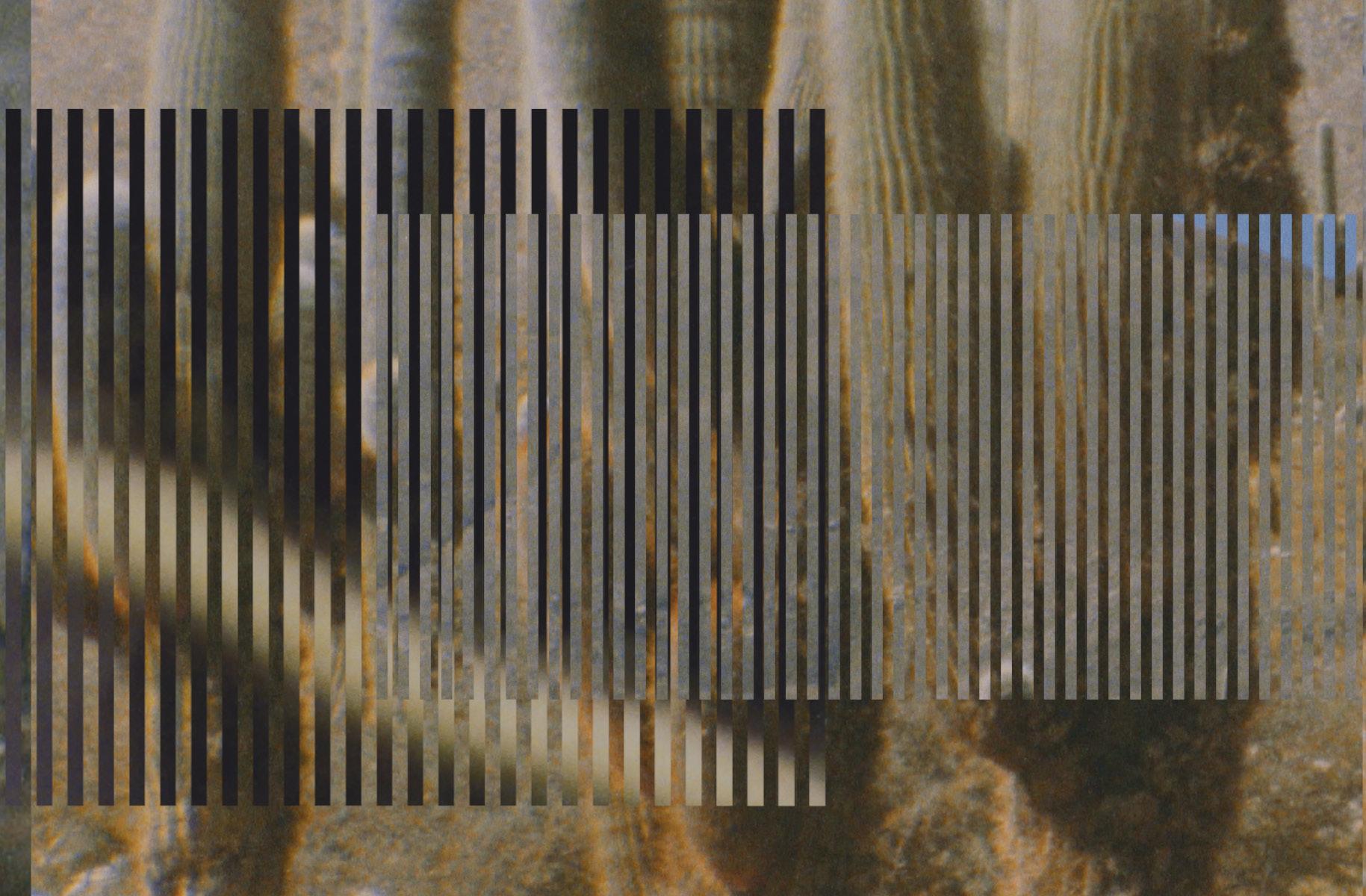
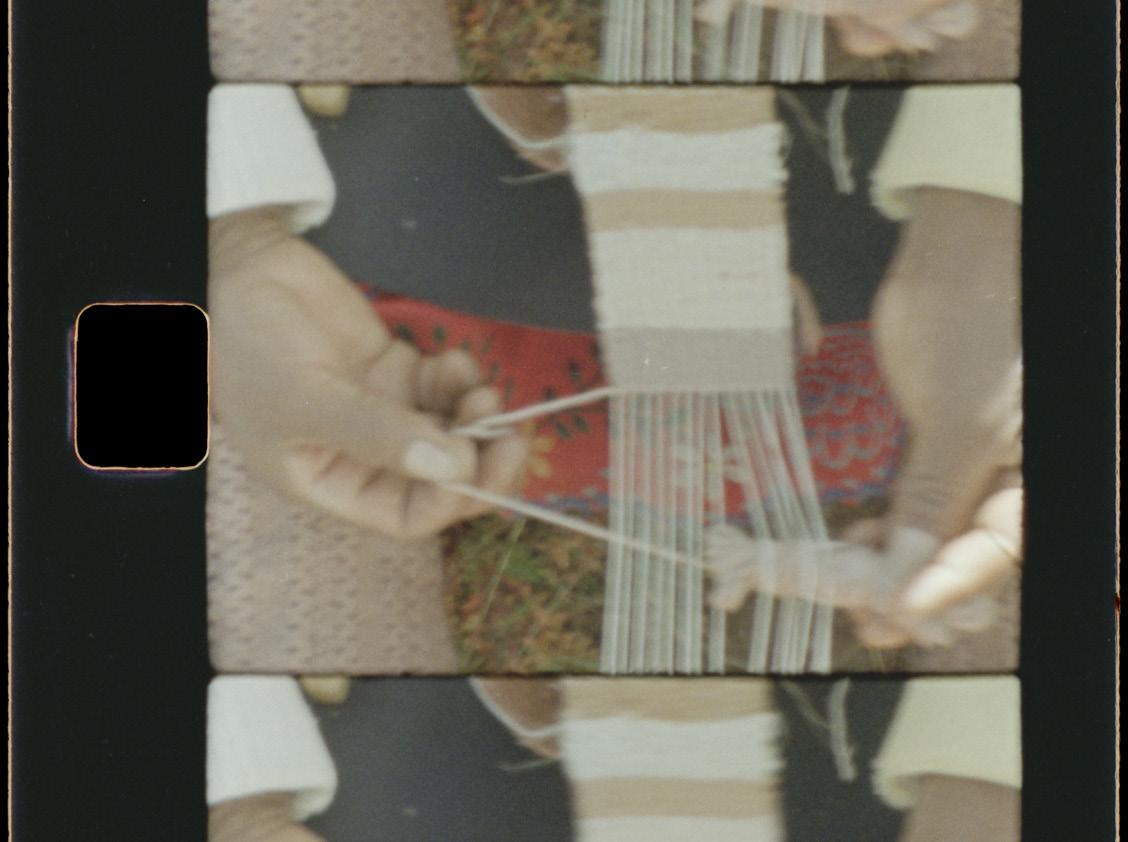
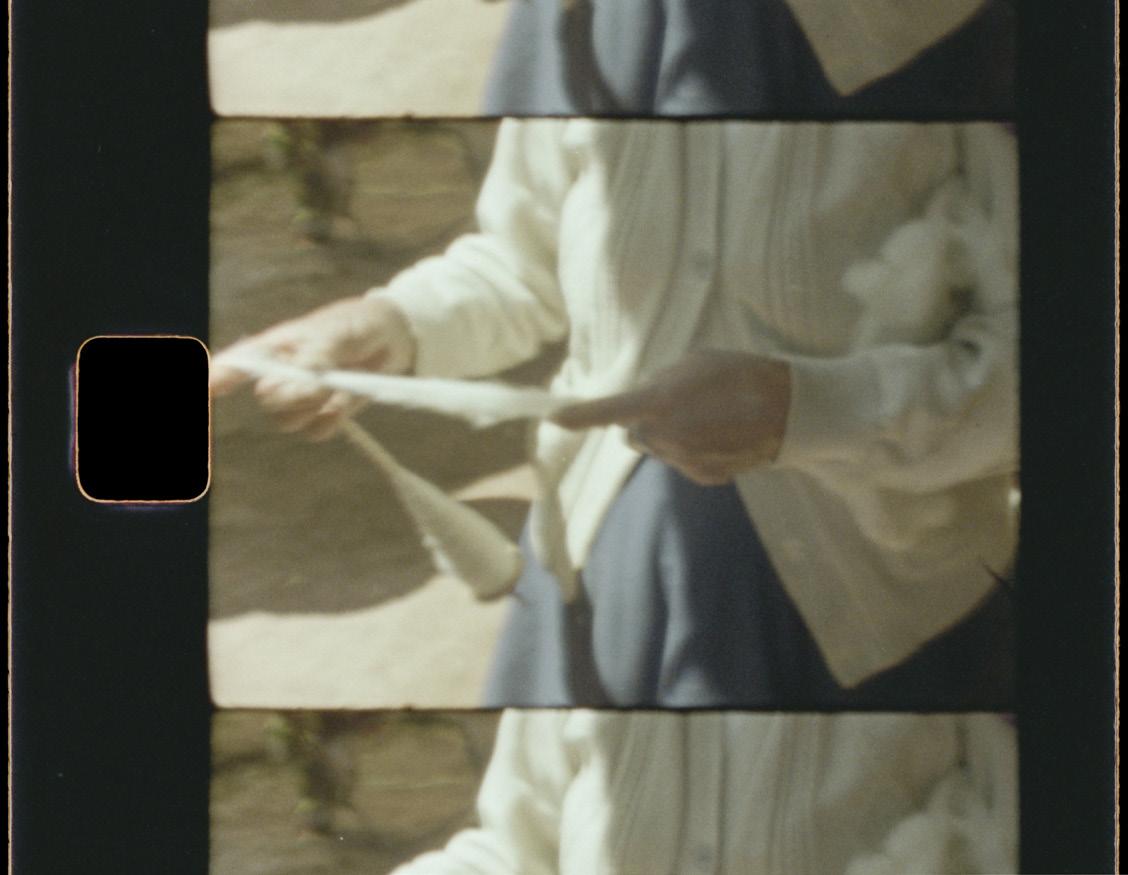
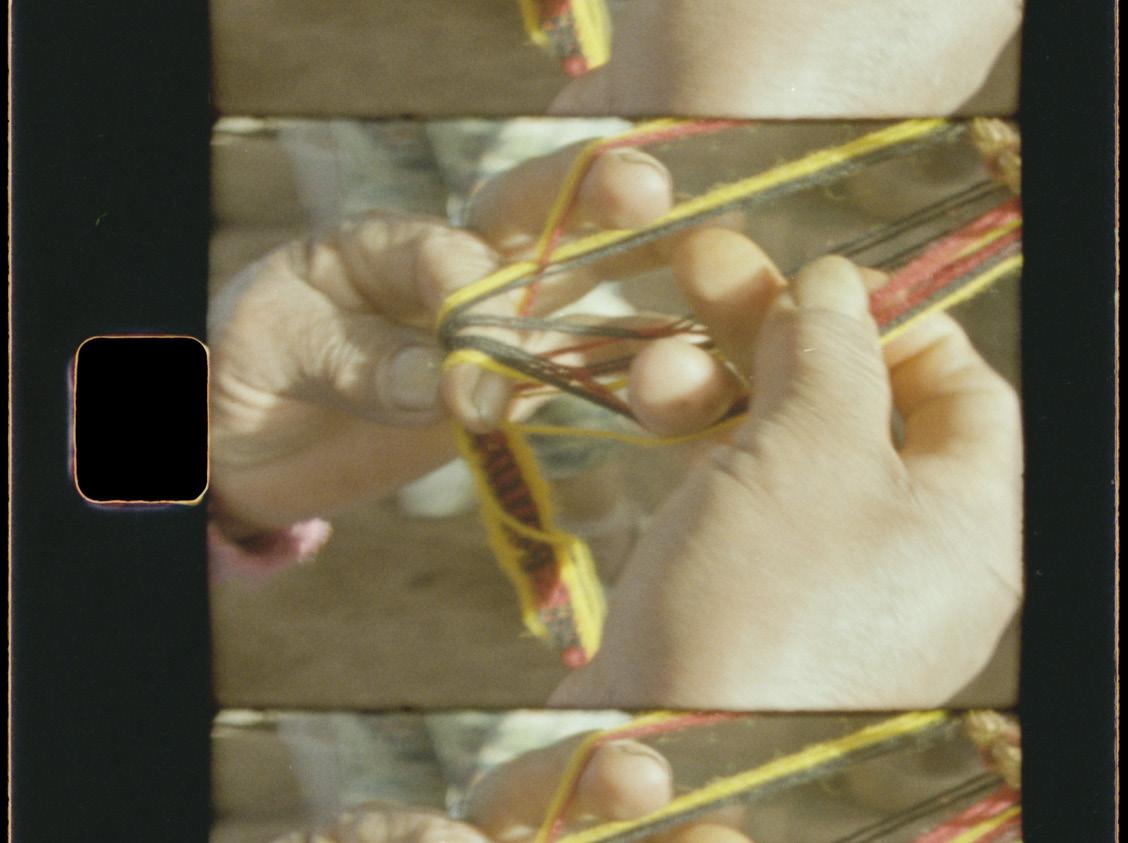





In Rhapsody, Jimena Sarno invites visitors, the community, and collaborators to craft tools and relationships that can reshape the present and, ultimately, work to collectively repair the tears in the social fabric. The exhibition encourages us, in the artist’s words, to “discard the idea of utopia as a grand horizon”1 imagined by an elite few impacting the many, and instead insists on the potential of intimate actions on a local scale to shape reality.
For Rhapsody , Sarno has gathered collaborators—mostly from the Global South—to contribute objects, soundscapes, and films that work toward visions for just futures. Many of the objects in the exhibition are made using techniques associated with folk and craft traditions, including weaving, woodwork, felting, and pottery. These ways of making and forms of embodied knowledge are often passed from maker to maker in an intimate system of knowledge-sharing. Sarno learns a new craft for nearly every project, from carpentry to ceramics. For Rhapsody , she studied weaving traditions in Perú, Argentina, and Morocco. Sarno contends that learning how to make something and gaining an intimate knowledge of materials can provide people with autonomy and agency. Many of her collaborators approach materials through what Sarno calls “Third World vision” 2 :
a way of approaching and experimenting with materials and techniques informed by resourcefulness in the face of scarcity, repairing, reconfiguring, or reimagining what is readily available. Sarno sees Third World vision as rooted in both environmental sustainability and sustainable practices of working, including attending to the value of labor and power of worker-owned production. Many artists who have contributed work to Rhapsody hold deep knowledge of and respect for traditional and craft ways of creating. Far from seeing them as fixed or unchanging, they use these tools to address contemporary concerns. Their work undoes the supposed “high/low” seams between the categories of “contemporary” and “traditional,” and “art” and “craft.”
Cultural production—including architecture, functional objects, and sculpture— has been mobilized as a tool for worldmaking across the political spectrum, from nationalist and fascist regimes seeking control, to revolutionaries fighting for liberation, to communities striving to reflect new futures. Consider the adoption of neoclassical aesthetics in an attempt to situate democracy in the early United States by architects including Thomas Jefferson, and sculptors like Hiram Powers and Edmonia Lewis; the monumental scale of fascist architecture under Benito Mussolini and Adolf Hitler; the design and dissemination of protest posters by
Jimena Sarno, footage digitized for Rhapsody (weaver and spinning while walking in Calca, Perú), May 2024. Super 8 film stills. Courtesy of the artist
1. Unless otherwise noted, all quotations from Jimena Sarno are from a series of conversations with the author in 2023–25.
2. Coined during the Cold War to refer to countries aligned with neither the United States nor the Soviet Union, “Third World” is frequently used pejoratively to refer to countries with developing economies, many of which have colonial pasts. Like groups including Third World Approaches to International Law, Third World Women’s Alliance, and Third World Gay Revolution, Sarno reappropriates “Third World” in this context.
student-led activist organizations in the 1960s; or the U.S. administration’s addition of gold decor to the White House in 2025. In recent years, Sarno has examined the utopian aspirations of modernism—particularly as applied to Latin America—and the ways these aims fell short in execution.
Sarno recently conducted field research at the Bauhaus, the globally influential school of art, architecture, and design founded by architect Walter Gropius in Germany in 1919. The Bauhaus began as a utopian project, aiming to create a “new guild of craftsmen” that would make thoughtful design and creative skills widely accessible, as Gropius emphasized, “without the class distinctions which raise an arrogant barrier between craftsman and artist.” 3 Many familiar characteristics of modern design, including the use of unadorned, simple forms, industrial materials such as glass and chrome, and the unification of craft with mass production, were shaped by the Bauhaus’s program. Sarno has long found modernist aesthetics to be seductive. She recalls of the Bauhaus’s famously rectilinear, concrete-and-glass façade in Dessau, “When I was a kid I thought that when you died and went to heaven, the entrance was a modernist building just like this one.”4
Over the course of her research, however, Sarno was struck by the ways that modern aesthetics emphasize progress and the “new.” The practices of many of the Bauhaus’s most influential artists and designers, including artist and
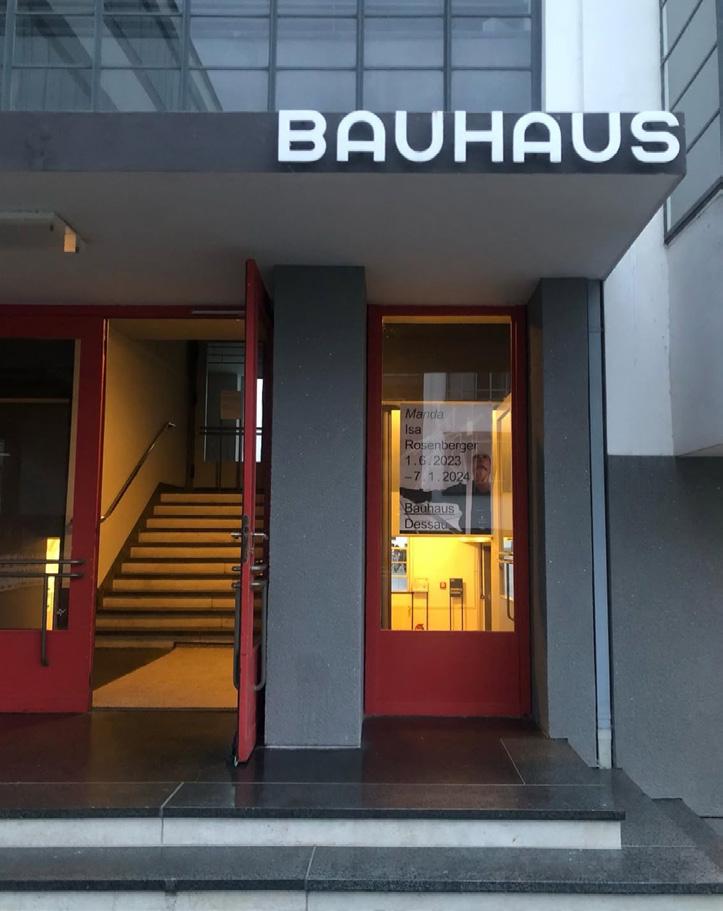
writer Anni Albers, were shaped by Moroccan and pre-Hispanic Andean textiles, often without an understanding that the visual languages of these textiles were not purely abstract. With designs that cast aside the meanings and cosmologies embedded in these local and Indigenous traditions, modernism became an apt tool for reinforcing global systems of colonialism, capitalist consumption, and control in the name of progress. Utopian nationalist enterprises throughout Latin America adopted Bauhaus-inflected modernism both in architecture and in objects for everyday living as symbols of future-oriented modernity in the wake of independence from colonizers, including Oscar Niemeyer’s designs for Brasilia; home furnishings by Dujo and EMPROVA in Cuba; and hospitals, schools, municipal
3. See “From the First Proclamation of the Weimar Bauhaus,” in Herbert Bayer, Walter Gropius, and Ise Gropius, eds., Bauhaus, 1919–1928 (New York: MoMA/New York Graphic Society, 1938), 18.
4. Jimena Sarno, Instagram post from June 14, 2023.
5. José Esteban Muñoz, Cruising Utopia: The Then and There of Queer Futurity (New York: New York University Press, 2009/2019), 12.
buildings, and affordable housing built in Argentina (where Sarno grew up) under Juan Perón’s rule. Sarno notes,
In modernist design, there’s a time division between what is “traditional” and what is “contemporary”: what is deemed “traditional” is seen as inactive. [I was also researching] modernism as a form of utopia, which started with a desire to democratize design, but ultimately became a tool for social planning and control. Modernist aesthetics became both a display of privilege, and also a way of asserting and preserving dominance through marking the past as inactive, uncivilized, or primitive, and the future as characterized by Western ideals of progress divorced from these traditions. I was interested in thinking or imagining, instead, a continuity with traditional aesthetics and ways of making.
Sarno’s alternate approach to design aesthetics, shaped by her visions for a better future, dovetails with theorist José Esteban Muñoz’s argument that “hope is spawned by a critical investment in utopia, which is nothing like naïve, but instead, profoundly resistant to the stultifying temporal logic of the broken-down present.”5 Sarno shares Muñoz’s belief in the potential of using utopian thinking to resist oppressive systems of power. While fascist visions of utopia are often built on an understanding that progress
is linear, and that singular, great geniuses are the means by which society progresses, Sarno’s visions of the future—shaped by Third World vision— center collective work, ideation, and creation. The works in Rhapsody emphasize the practical, reparative work that can be done in the present to shape and defend our future.6
Sarno asks, “Besides resisting or rejecting colonial and fascist regimes, how can we imagine, collectively, in our state of permanent crisis, other versions of the here and now?” Within a global context of extreme violence, fragmentation, and destruction, Sarno recalls that “as I considered starting points for the exhibition, and the idea of relevance during a genocide, I had a really hard time visualizing a future, and a project in that future.” Sarno asks—along with generations of activists, artists, and critics, including Palestinian thinkers Edward Said and Mohammed El-Kurd— “What is the role of cultural production in a liberation struggle?”7 Ultimately, for Sarno, “the only conceivable approach for this moment was to think about our collective responsibility to rebuild and repair.” As she explains, “the work insists on the idea of a tangible future and on the local, domestic, and intimate circles of influence and mutual care that each of us are capable of accessing.”
6. From Maria Lugones’s introduction to Pilgrimages/Peregrinajes: Theorizing Coalition Against Multiple Oppressions (Lanham, MD: Rowman & Littlefield Publishers, 2003), 5: “This is also a commitment against utopianism, which seems to me what keeps one out of despair when one cannot act, at all. [...] The commitment is to live differently in the present, to think and act against the grain of oppression. I write from the belief that it is only from that ground that the next possibility can be entertained socially, at the edge of realism.”
7. Cultural critic and theorist Edward Said wrote, “Culture is a form of memory against effacement. In that respect, I think it’s terribly important. But there’s another dimension of cultural discourse—the power to analyze, to get past cliché, and straight out-and-out lies from authority, the questioning of authority, the search for alternatives. These are also part of the arsenal of cultural resistance.” [Edward Said, from David Barsamian and Said, Culture and Resistance: Conversations with Edward W. Said (Cambridge, MA: South End Press, 2003), 159.] El-Kurd—a contemporary Palestinian poet, journalist, and activist—is understandably ambivalent: “Artists, writers, intellectuals, diplomats, journalists, academics, those operating in the public sphere, can and have influenced international public opinion in many instances across history. But sometimes, I’m tempted to say otherwise. I’m tempted to say that it’s all smoke and mirrors, that after all the poems and essays and speeches, there is not a dent in the status quo.” [Mohammed El-Kurd, Perfect Victims: And the Politics of Appeal (Chicago: Haymarket, 2025), 187–88.]
The title of the exhibition—and of the newly commissioned installation at its core—follows the multiple meanings of “rhapsody,” including the musical composition characterized by improvisation and an ancient Greek form of epic poetry performed by a rhapsode, someone who stitched songs and legends together, translating them for new audiences. The improvisational nature of a rhapsody is manifested both in the openness of Sarno’s invitations to dozens of collaborators to participate in Rhapsody and in the ongoing reconfigurations of the exhibition. With new works being added over the course of the exhibition, Rhapsody, like the futures it envisions, remains in flux, mobile and uncertain, refusing a single, fixed narrative. The contributions by Sarno, her collaborators, and community members emphasize our shared responsibility for working collectively to shape a more just future that shimmers at the horizon.8
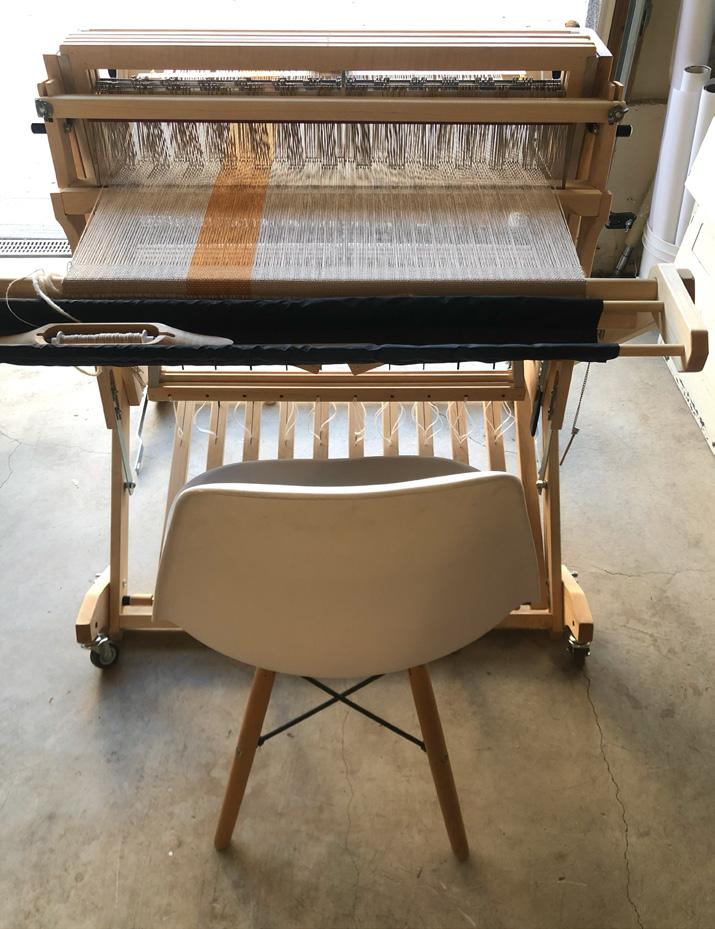
Beginning in 2024, Sarno traveled to Perú, Argentina, and Morocco to learn weaving traditions from artists, including Milagros Colodrero, Alicia Leyme, and Celeste Valero.9 Sarno is particularly interested in the potential futures that can be imagined through Andean weaving traditions, in which textiles are bearers of information and stories in addition to being usable objects. Denise Y. Arnold and Elvira Espejo write that, within Andean cosmology, textiles are thought of “not only as passive objects, rather they are beings interacting with the world and have the capacity to animate the relations between individuals and groups of people, including the creation of wider networks of interchange.”10 Sarno was struck by this understanding of weavings’ ability to facilitate community and collectivity—and perhaps even to aid in repairing the damage done by past and present injustices and violence.
Sarno began to document not only her process of learning to weave but also the landscapes that were home to the traditions from which she learned. For Rhapsody, she weaves together this material in a 100-foot-long projection, in which vertical bands of footage juxtapose, for example, an intimate shot of Sarno’s hands weaving on a small tabletop loom with the sweeping skies and mountainous desert of Argentina’s Jujuy province. Bringing together seemingly distant locales, Sarno proposes a model of solidarity shaped by Third World vision, aligned with movements for solidarity in 1968 and later, including the Third World Gay Revolution’s 1971 manifesto, which argues: “We each organize our people about different issues; but our struggles
are the same against oppression, and we will defeat it together.” 11 Sarno explains, “The loom with its warp and weft functions as a narrative space. By filming my weaving learning practice, I transpose this generative space onto the exhibition space as a monumental-scale projection in which film montage echoes the weaving process.”
A group of artist-made tools sit in front of the film at the physical and conceptual center of Rhapsody . Sarno invited more than two dozen makers to contribute works in response to the following prompt:
Contrary to existing museums that house objects from the past (often
looted and decontextualized), we are collectively putting together a collection of objects for future use. The objects are tools for a future that respects the interconnectedness of all beings. What moment in the future is your object made for?
Sarno’s collaborators have offered reflections on these futures, and on how they hope their speculative tools might be used. In their writings, they often reference characteristics that Sarno identifies with Third World vision, including the art of reuse and repair, and a sense

Want,
drafted November 11, 1970, to supercede the 13 Point Platform drafted September 9, 1970, archived by Pinko, October 15, 2019, https://www.pinko.online/sixteen-point-platform-and-program/#:~:text=What%20We%20Want%2C%20What%20We,to%20determine%20our%20own%20destinies.
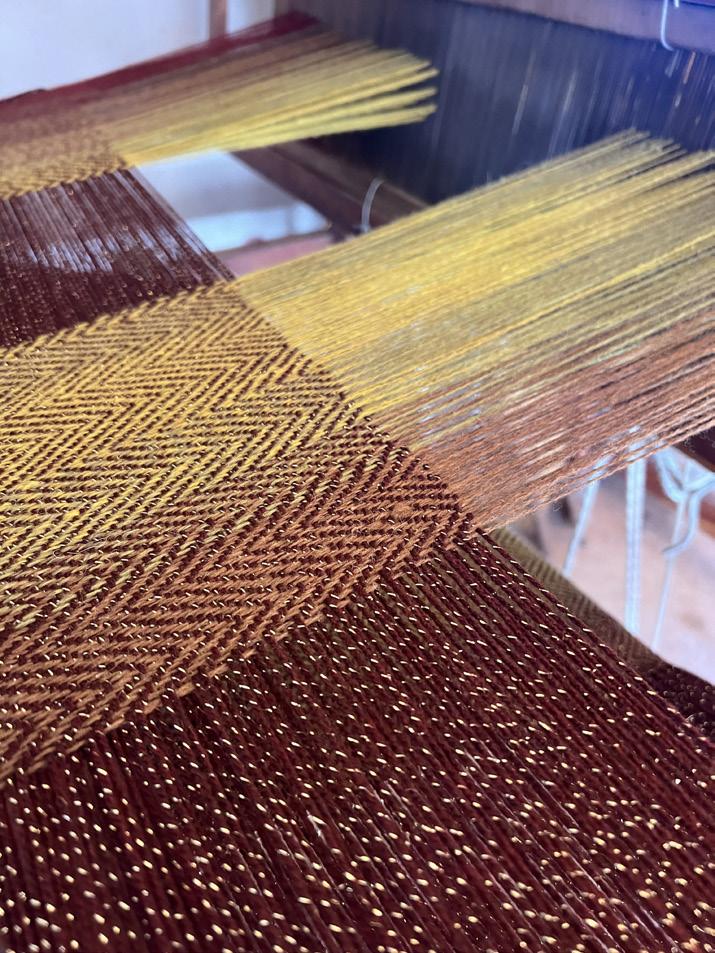
of contiguity not only with the past and with craft traditions but also with other beings. For Sarno, her collaborators’ emphasis on “sustainability respects this interconnectedness.” Celeste Valero reflected on the particular ways that textiles encourage us to consider these relationships:
Los tejidos son compañeros de existencia, ellos nos recuerdan sobre el vínculo con otredades. Son abrigo y memoria, ellos nos conectarán con el saber y el latido de la tierra.12
[Fabrics are companions of existence, they remind us of our ties with otherness. They are shelter and memory, they will connect us with the knowledge and the heartbeat of the earth.]
Within the context of Andean cosmology, as Sarno learned from Indigenous weavers including Valero, “All things are beings: rocks, stars, planets, weavings. There is mutual care within these beings. Living in right relation to all beings is rooted in an understanding of everything as woven together, as part of a web.”
Josefina Puch reflected on the way that the Aymara people (who live in the Altiplano and Andes regions of South America) envision time, which includes la imagen del futuro caminando detrás de uno, el presente como el lugar donde estamos parades, y el pasado visible, extendido hacia adelante, frente a nuestros ojos. Desde que recuerdo, tengo esa no percepción del futuro. No puedo visualizarlo con claridad, aunque me esfuerce. […] Al imaginar objetos para un futuro posible, aparecen formas conocidas: les otorgo valor por su origen, por su manufactura, por las marcas que deja el uso, por la transformación que ya han atravesado. El futuro lo intuyo a través de las huellas del pasado.13
[the image of the future walking behind us, the present as the place where we are standing, and the visible past, extended forward, in front of our eyes. As long as I can remember, I have had this same lack of perception of the future. I can't visualize it clearly, even if I try. […] When imagining objects for a possible future, known shapes appear: I give them value for their origin, for their manufacture, for the marks left by use, for the transformation they have already gone through. I sense the future through the traces of the past.]
Sarno shares Puch’s sense of the future as rooted in “las huellas del pasado”— the traces of the past—and draws a connection with Aymara/Bolivian feminist sociologist, historian, and activist Silvia Rivera Cusicanqui’s writings, who argues,
The indigenous world does not conceive of history as linear; the past-future is contained in the present. […] The project of indigenous modernity can emerge from the present in a spiral whose movement is a continuous feedback from the past to the future—a ‘principle of hope’ or ‘anticipatory consciousness’—that both discerns and realizes decolonization at the same time.14
The tools in Rhapsody are displayed on portable tables and armatures, poised as if ready for use, rather than under glass like the artifacts often displayed in historical museums, which are torn from the contexts in which they could be enlivened through use. Instead they cast their shadows against the video like actors against a backdrop. They will grow in number over the course of the exhibition, accompanied by Sarno’s massive video projection and looping, changing soundscapes composed by collaborators, including Dirar Kalash, Mhamad Safa, Bergsonist, and Val Jeanty. The sonic compositions range from field recordings of weavers at work and the sounds of their surrounding landscapes, to experimental percussion. A satellite screening room will host a rotating selection of films by artists and directors that resonate with the themes of the exhibition. These tactics of iteration and reconfiguration offer a counter to modernist narratives of progress, rejecting the purported disjuncture between the contemporary and the traditional.
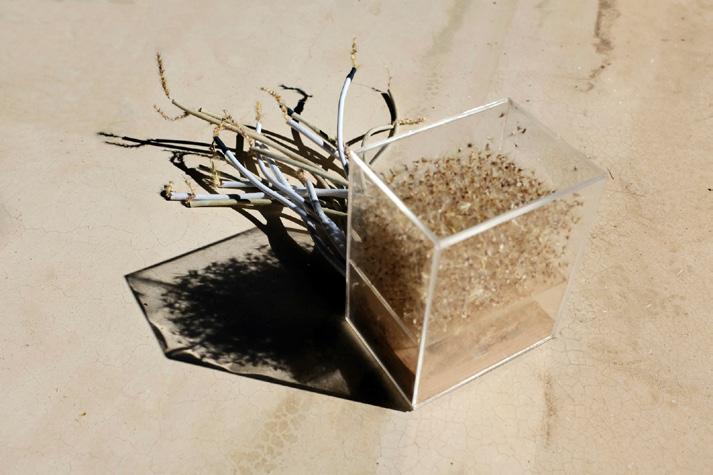

14. Silvia Rivera Cusicanqui, “Ch’ixinakax utxiwa: A Reflection on the Practices and Discourses of Decolonization,” trans. Brenda Baletti, The South Atlantic Quarterly 111, no. 1 (Winter 2012): 96.
Las Tres Gracias is an operatic installation in which Sarno draws on creation legends and Third World literature to “reexamine western civilization’s myth of democracy and the architecture and role of theater as both a political and pedagogical experiment.” The installation is named for a neoclassical sculpture by Italian artist Antonio Canova, Las Tres Gracias (The Three Graces) , which depicts the three daughters of the Greek god Zeus, believed to bestow beauty, mirth, and grace upon humanity. The two video channels, which Sarno shot on Super 8 film, attempt to reconstruct her childhood memories of the sculpture as it stood in the botanical gardens of Buenos Aires and her subsequent search for it, after she visited the park and found that it had been removed.
The installation adopts the structure of Greek tragedy, with three standing felt-covered speakers cast as actors playing the Graces, and a crowd of eight suspended bullhorn speakers— icons of both authority and resistance— as the chorus. Sarno chose felt for its muffling and warming effect. The libretto sung by the Graces (compiled by Sarno, with music by American composer and vocalist Molly Pease and Italian percussionist Valentina Magaletti) incorporates ancient South American creation myths and writings by poets, journalists, and revolutionaries addressing colonial plunder, extraction, and our collective responsibility to repair the damages wrought by imperial and colonial violence, in order to live in just relation with all beings. The Graces’ words, sung in Spanish, are echoed in an English whisper by a fourth felted speaker across the room. Refusing to


be consigned to the dustbins of history, these words and phrases have an eerie timeliness, voicing our continuity with the past and the ongoing presentness of struggles for liberation.
Nadie se resigna a quedar mundo y sin memoria
Los intelectuales son rebeldes, pero no revolucionarios
[No one resigns themselves to become mute and without memory Intellectuals are rebels, but not revolutionaries]
decide el gobierno que la realidad no existe
[the government has decided that reality does not exist]
En Utopía no existe el dinero ni la propiedad privada.
[In Utopia neither money nor private property exist]
Film still (above) and installation view (left) of Jimena Sarno, Las Tres Gracias, 2024. Super 8 film transferred to video. 12-channel sound, 2-channel video installation, 17:08 min., looped. 8 suspended PA speakers with 8-channel percussion. 4 felted speakers on felted C-stands with 4 voice channels, USB interfaces, 12 amplifiers, speaker wire. Dimensions variable. Courtesy of the artist. Commissioned by Pitzer College Art Galleries. Photo: Chris Wormald
Drawing on the Latin word “texere,” meaning “to weave” (the shared root of the words “text” and “textile”), the Text/ ile Library features writings by cultural critics and theorists, historians, poets, and artists, including Anni Albers, Julia Bryan-Wilson, Silvia Rivera Cusicanqui, Eduardo Galeano, and José Esteban Muñoz, and textiles by Leonor Barreiro, Rosa Diaz, Alicia Leyme, and others. These thinkers and makers provide context for and have influenced Sarno’s practice. By bringing together written texts and textiles, Sarno encourages us to recall that many textiles act as bearers of information for those who learn to decipher them.
Colonial and authoritarian governments have historically privileged the documentation and knowledge contained in institutional archives—from birth and citizenship records, to the manifests of ships including those bearing people to slavery, to plundered objects in museums—over other forms of knowledge. Those archives, in turn, shape how histories are told, often in ways that support and reproduce the power of the institutions maintaining the archives.15 Sarno’s exhibition asks, What would it look like to contend with these systems of knowledge and unweave the threads of the archive’s imperial structures? The Text/ile Library suggests expanding our studies beyond the types of documents that archives typically preserve. Sarno’s Text/ile Library engages, recovers, and honors, instead, bodies and forms of knowledge that such systems push to the margins, and those
shared via intimate networks, iteratively and communally: maker to maker, scholar to scholar, activist to activist. The Text/ile Library works against the tendency to bureaucratically privilege the written word over forms of knowledge that cannot be easily archived and codified. These other ways of knowing include craft techniques (exemplified by the textiles in Sarno’s library), oral storytelling, dance, strategies for repair, and traditional healing methods.
The library is housed in an open woodframed structure matching the dimensions of the artist’s home studio, and set at a slight angle to the floor. This porous, leaky structure frames the artist’s studio as a space of study and learning, rather than of mastery. The Text/ile Library likewise offers visitors to the exhibition a space of gathering for conversation, questioning, and exploration.
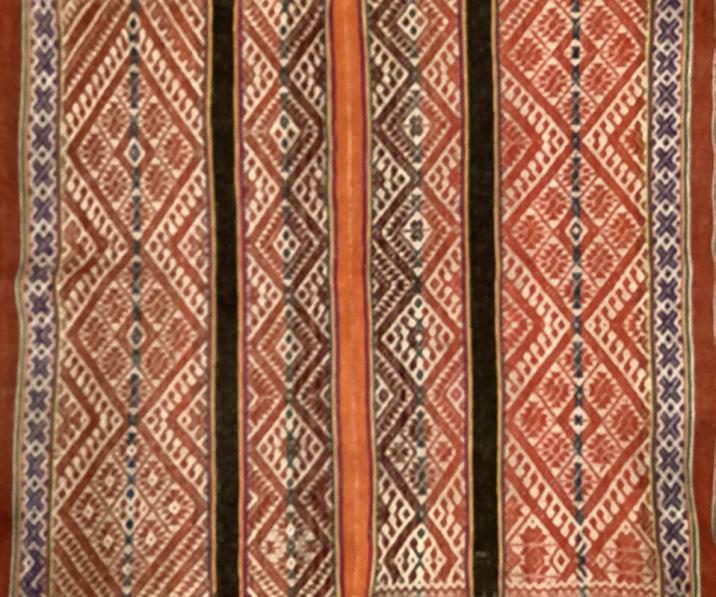
Life in the Forest , commissioned for Sarno’s exhibition at MASS MoCA, centers on the conservation of a family heirloom: a small doe and fawn, sculpted in wood by the artist’s late uncle in the 1950s. Sarno has collaborated with conservators to repair the original wooden sculptures using 3D scanning, wood carving, and gilding to replace missing ears and legs, inspired by traditions like kintsugi in Japan through which objects become even more beautiful by being repaired. The sculptures have been broken as long as Sarno has known of them, and the openness and uncertainty of how they “should” be completed was generative: she recalls, “The deer gave me the idea that perhaps I shouldn’t be thinking about answers, but I should be asking questions.”
Sarno traces the sculpture’s deer motif to Bambi: A Life in the Woods , a 1923 novel by Felix Salten allegorizing the ills of fascism. Life in the Forest features a soundscape sampled from the instrumental soundtrack for a 1970s musical based on Walt Disney’s 1942 Bambi movie, which in turn was loosely based on Salten’s novel. The sonic composition accompanies a film shot in Super 8 documenting the repair process for the wooden deer, the deer’s 3D schematics, and the Bosque de Los Arrayanes in Argentina, which inspired the setting for Walt Disney’s film. Life in the Forest also includes excerpts from Salten’s book, and from a poem by Peruvian poet Rodrigo Quijano titled “Ahora bien, imagina que eres una bala” [Now, imagine you are a bullet], which addresses state violence.
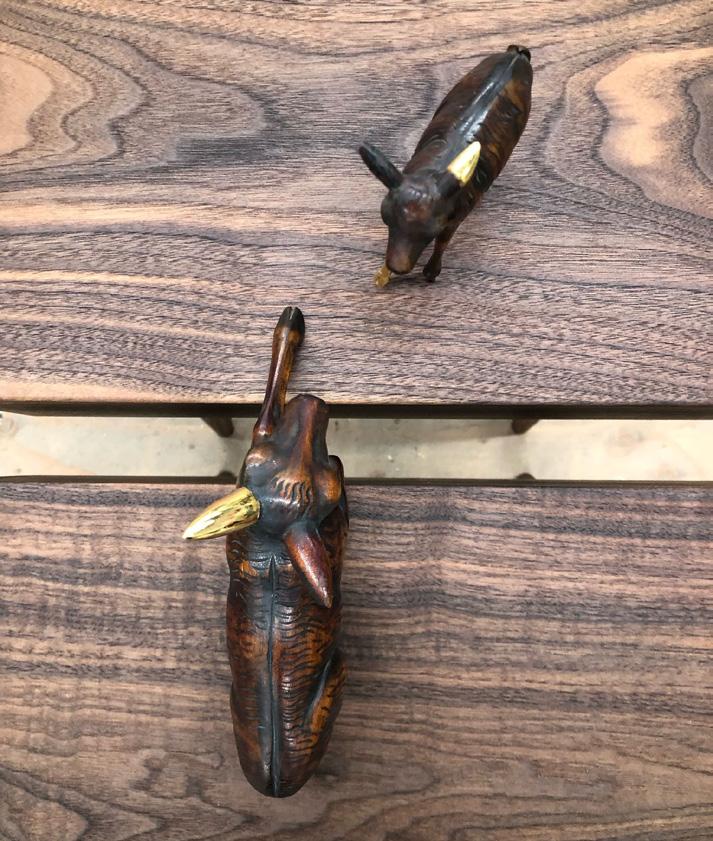
Throughout the filming of Life in the Forest , as in Las Tres Gracias , Sarno chased down a missing sculpture: a bronze rendering of a family of deer that she remembered from visits to a park in Buenos Aires as a child, another inspiration for her uncle’s sculptures. After months of conversations with local residents, park employees, and municipal bureaucrats, Sarno tracked the sculpture to a parking lot, where it was trapped behind a yellow barricade, supposedly in the process of being repaired, with no plans to restore it to its home in the park.
Moving between past and present, and fiction and memory, Life in the Forest incorporates experiences of looping temporality that refuse the forward thrust of progress. The recursive structure of time in the film intimates that—much like the legends and revolutionary poetry in the libretto for Las Tres Gracias—the generational violence of intolerant, authoritarian regimes persists and repeats until we
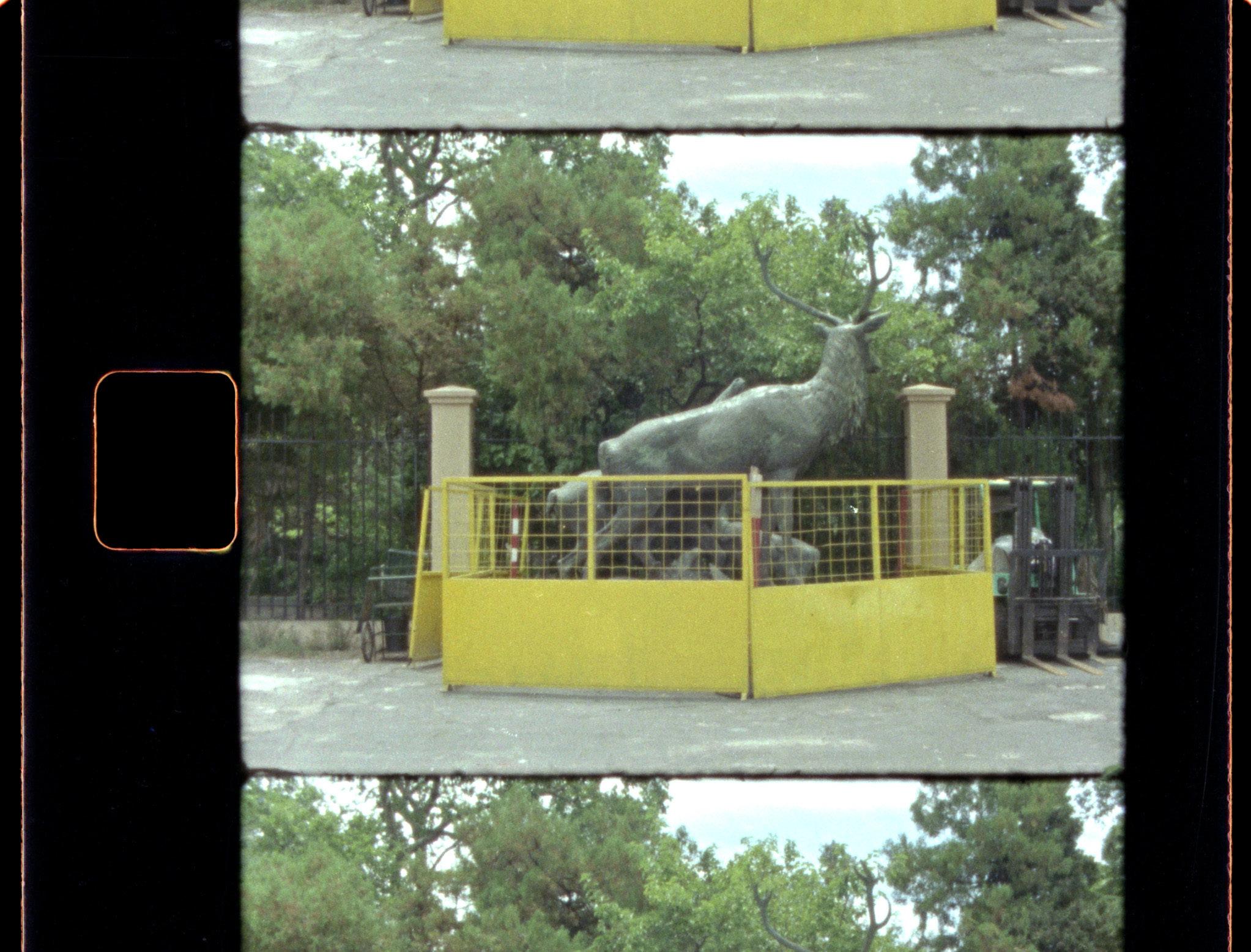
take active steps to repair the damages they have wrought.
Alongside the wooden deer sculptures, Life in the Forest also features additional repaired objects. Over the course of the exhibition, the museum is hosting a series of workshops where community members can learn to repair textiles, wood, and ceramics. Participants are invited to lend the repaired objects to the exhibition following each workshop.
Weaving a more just future begins, as Sarno’s exhibition argues, with the collective responsibility to repair the rents in the fabric into which we are all woven—today, starting small.
— Alexandra Foradas, guest curator

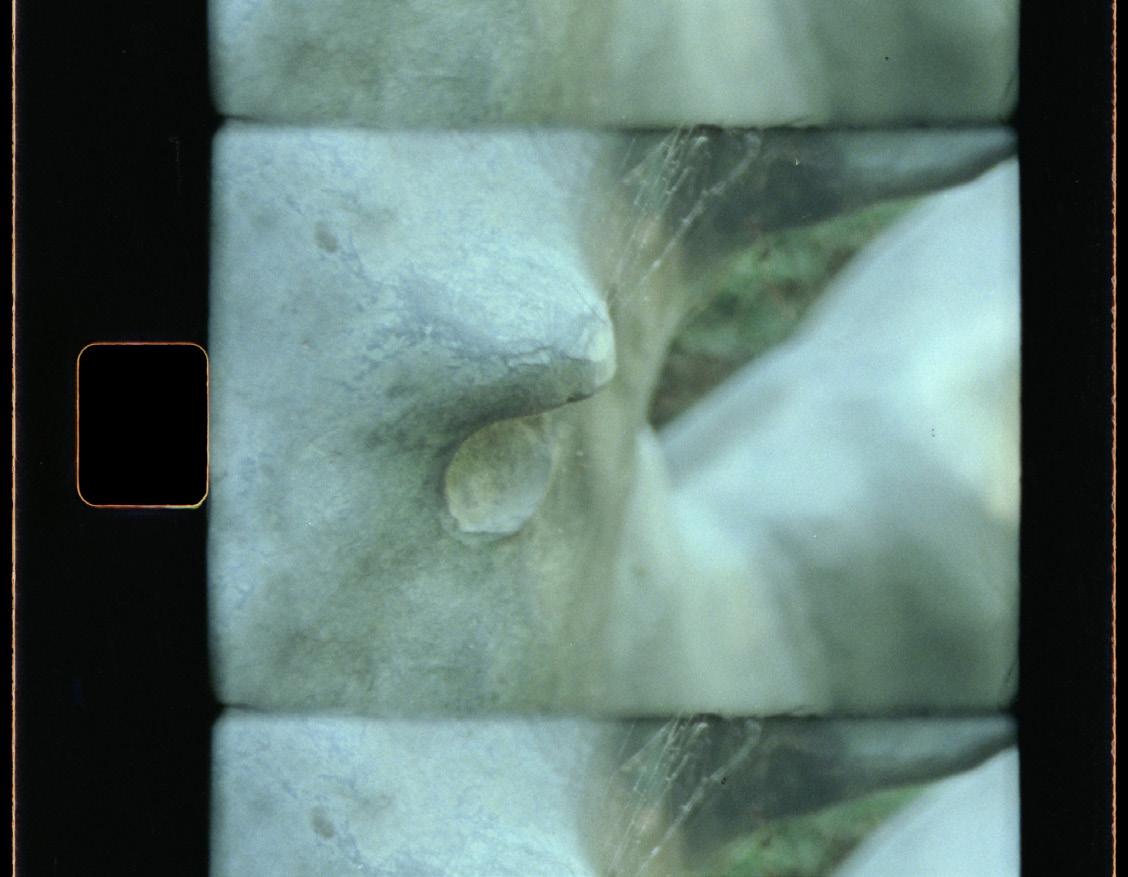
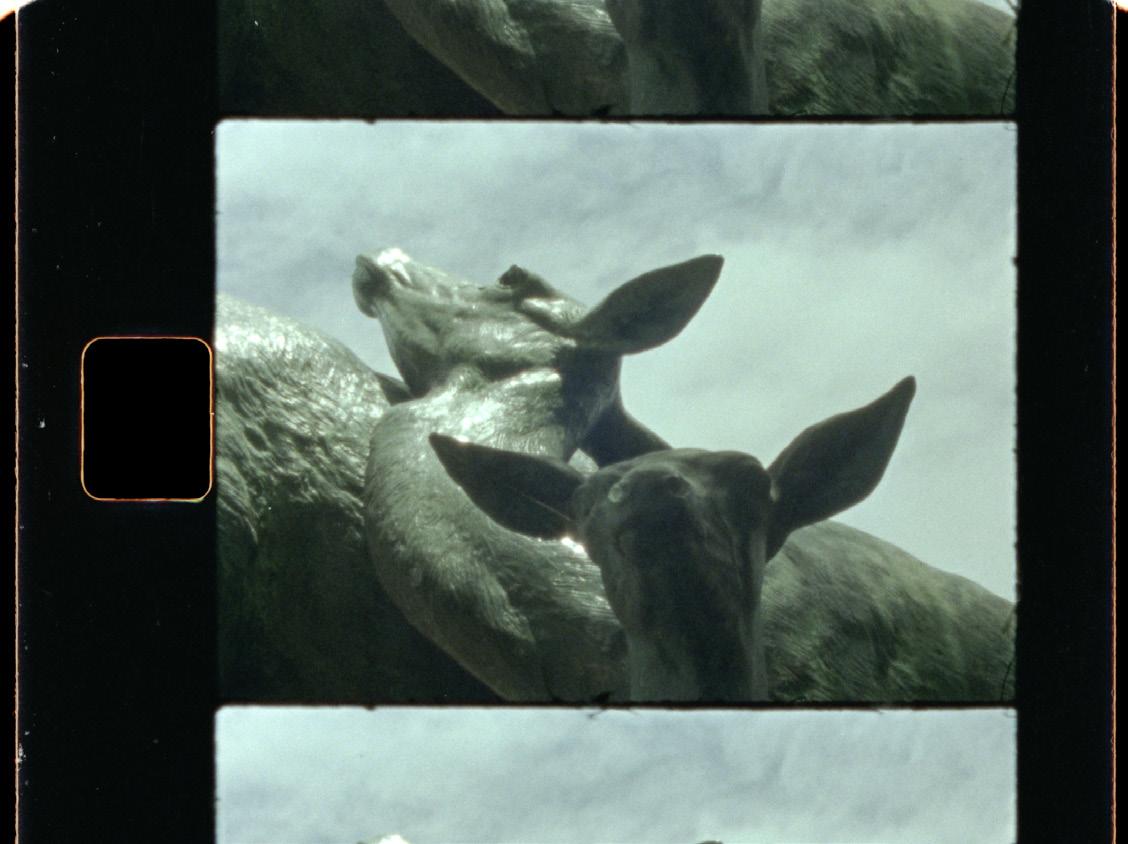
Jimena Sarno is an interdisciplinary artist and educator born in Buenos Aires, Argentina, and based in Los Angeles. With a focus on the sensorial and affective experiences shaped by political subjecthood, she works across a range of media, including installation, sound, video, text, and sculpture. Her work has been exhibited in solo and group exhibitions at MASS MoCA (Kissing through a Curtain, 2020); REDCAT, Los Angeles; Vincent Price Art Museum, Monterey Park, California; Clockshop, Los Angeles; 18th Street Arts Center, Santa Monica; LACE, Los Angeles; Visitor Welcome Center, Los Angeles; Museum of Latin American Art, Long Beach, California; Mistake Room, Los Angeles; Human Resources, Los Angeles; PØST, Los Angeles; UCI Contemporary Art Center, Irvine, California; Grand Central Art
Center, Santa Ana, California; Control Room, Los Angeles; San Diego Art Institute; Luminary, St. Louis, Missouri; and Centro Galego de Arte Contemporánea, Santiago de Compostela, Spain; among others. Her work has been supported by the California Arts Council Individual Fellowship, the California Community Foundation Fellowship for Visual Artists, the Foundation for Contemporary Art Emergency Grant, and she is 2023–24 Lucas Artist Fellow in Visual Arts at Montalvo Arts Center, Saratoga, California.
Jimena Sarno: Rhapsody October 18, 2025–January 2027
Curated by Alexandra Foradas, guest curator
Support for Rhapsody is provided by The Coby Foundation, Ltd. Programming at MASS MoCA is made possible in part by Mass Cultural Council.
Cover: Jimena Sarno, Rhapsody (detail of film still), 2025. Color 16 mm and Super 8 film transferred to video, with audio and installation. Courtesy of the artist. Made with MASS MoCA
